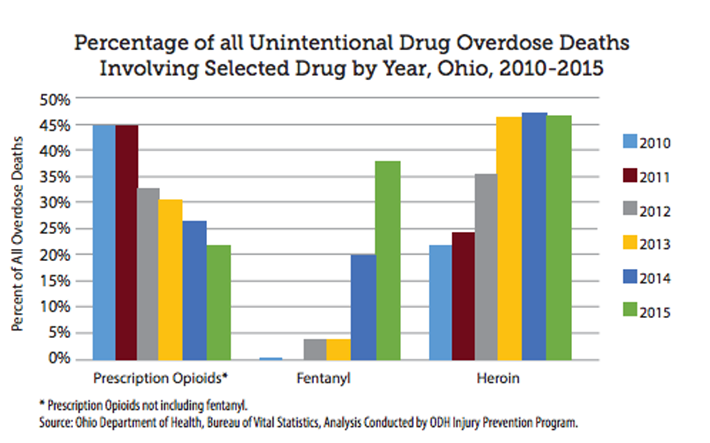Is the Focus on Opioid Fatalities too Narrow?

In state after state, officials are declaring epidemics and states of emergency because of the increasing number of opioid overdose deaths. The obvious cause is the number of people who are losing their lives to this category of drug that includes painkillers, heroin, illicitly-manufactured fentanyl and similar drugs like the animal tranquilizer carfentanil. Yes, we need to save lives but could this focus on opioids ultimately be too narrow?
Here are some of the actions we’ve seen by state officials since this crisis began.
As far back as 2014, Governor Shumlin of Vermont declared that opioid overdoses in his state were a crisis and devoted his State of the State Address to this topic. In 2016, legislators in both Ohio and Virginia took measures to declare public health emergencies, while this year West Virginia, Maryland and now Florida have followed with similar measures.
When an emergency is declared, what happens? It varies by state but the resulting changes could include these:
- Judges could be given the discretion to divert some individuals from criminal penalties to rehabilitation services.
- The opioid reversal drug naloxone may be purchased by the state in large quantities for distribution to first responders and families could be given permission to buy this drug that is normally prescription-only.
- Initial prescriptions for opioid drugs could be limited to seven days or less. Prison terms may be lengthened for those selling opioids that result in a person’s death.
- Licensing boards could be given more authority to investigate prescribers suspected to illegal activity.
- Funding could be released to provide more treatment beds.

One thing is certain. Opioids are killing Americans. Year by year, it’s increasingly heroin and fentanyl and not prescription drugs. This graph from Ohio provides evidence of this shift.
The middle section shows the growing number of overdoses from fentanyl and the section on the right shows the number of overdoses from heroin. Fentanyl overdoses jumped up dramatically while heroin ODs increased and then leveled off.
Could There be Any Error in Our Narrow Focus on Opioids?
Perhaps. Certainly, we must push back using any available tools to reduce these deaths. But is it right to focus only on opioids? Most people who use drugs actually use more than one kind of drug, either simultaneously or sequentially.
It’s quite common for toxicology reports after a drug-related death to list multiple drugs found in the person’s body.
Trans-Siberian Orchestra founder Paul O’Neill died in April 2017. In his toxicology report, the coroner noted “methadone, codeine, diazepam and an antihistamine.” Diazepam is the generic name for Xanax.
When the WWE star Chyna died, the toxicology report stated that she had painkillers oxycodone and oxymorphone, anti-anxiety drugs Valium and nordiazepam, sleeping pill temazepam and alcohol in her body.
In 2015, rocker Scott Weiland of Stone Temple Pilots had cocaine, alcohol, and a form of ecstasy in his body when he died.
Even when a person doesn’t intend to be mixing drugs, the supply he buys could have multiple drugs in it. Counterfeit Xanax bought on the street sometimes actually contains fentanyl, as do some supplies of cocaine. When the musician Prince died, he had fentanyl and illicit opioid
U-47700 in his system. It’s unlikely he was aware of the exact ingredients of the pills he was taking. He also had remnants of diazepam, lidocaine and hydrocodone in his body.
A Coroner’s Job
A coroner has an incredibly complex responsibility. In a drug overdose death with a number of substances present, he must determine which of many drugs was the causative factor in the death. That is how a death is identified as a “oxycodone death,” “heroin death” or “cocaine death.” Occasionally the sometimes the coroner can only state that “mixed drug toxicity” killed the person. This was the case with the death of young actor Cory Monteith in 2013.
So in the tens of thousands of drug overdose deaths each year, it’s very likely that heroin or fentanyl were not the only drugs found. The death goes onto a list like “heroin deaths” based on the coroner’s best judgment of which drug tipped the person into an irreversible decline.
Finding the Right Message
Is it right, then, to focus on heroin or fentanyl or opioids as a class? Would it perhaps be a better message if we encouraged children and adults both to lead drug-free lives?
If we discourage some people from using opioids, they might be just as happy to go find stimulants. A person who was overindulging in alcohol could perhaps switch to Xanax. They could be no better off. In fact, since fentanyl is being found so many different places these days, they could still die from an overdose of opioids even if they have no intention of using that kind of drug.
Perhaps sounding an alarm on one particularly dangerous class of drug must be done at times but surely it is just as important to encourage our friends and neighbors to pursue drug-free lives. Their greatest safety is in sobriety. Each person will be in their best possible shape to deal with raising children, driving a car, holding a job and being a good member of their community if they reject the idea of using any drugs at all and instead, construct a satisfying, productive life. This could be the most important and valuable message of all.


